Almost since the dawn of gaming, designers have debated which is more important: story or gameplay? Some designers believe games require a story to engage the player. Other designers think a story is what people use to describe play when it is finished. Pro-story designers reply that games are an artistic medium used to tell a story. Anti-story designers counter that a story is what you watch while the game loads. Designers at Game Developer Conferences all around the world face off against each other: one group yelling "Bioshock!" while the other side shouts "Doom!" back. Silly designers. They are both right and wrong. A game doesn't need to have a story, and yet it always has a story. Perplexing? While you are chewing that over, let's look at the classical definition of "story" as taught by everyone from Aristotle to very famous screenwriters. Here's the most basic structure of a story:
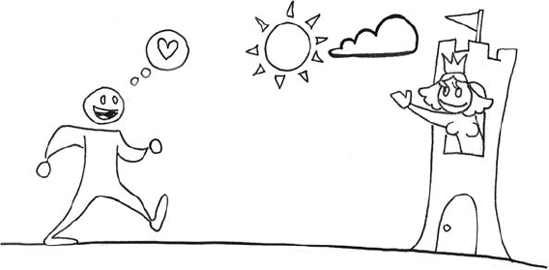
First, there is a hero who has a desire.
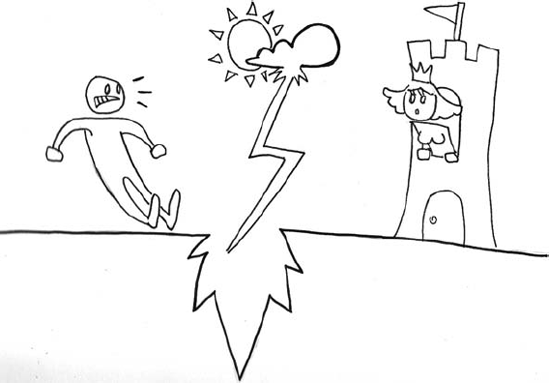
Our hero encounters an event that throws his life into disarray and interferes with obtaining the desire. This event causes a problem for the hero.
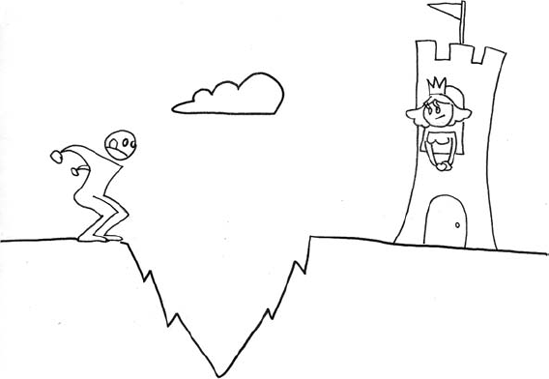
The hero tries to overcome the problem ...
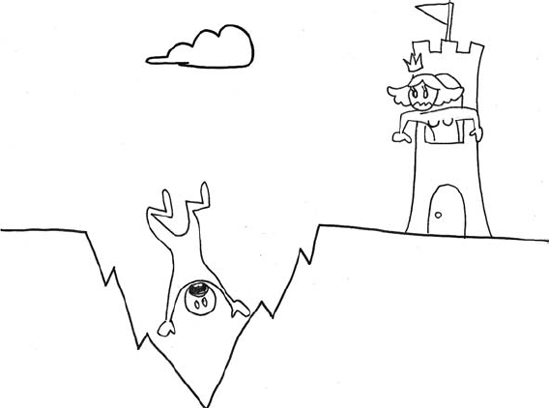
... but his method fails.
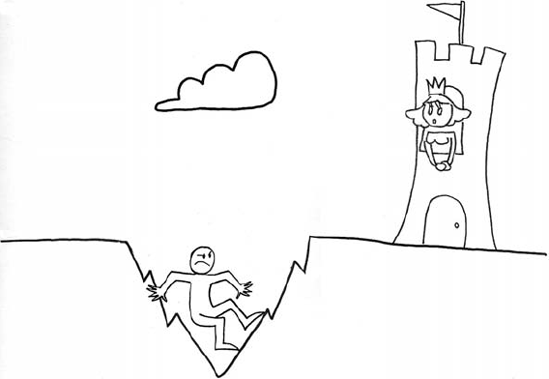
There is a reversal of fortune, which causes more trouble for the hero.

An even greater problem is created for the hero that puts the hero at greater risk.
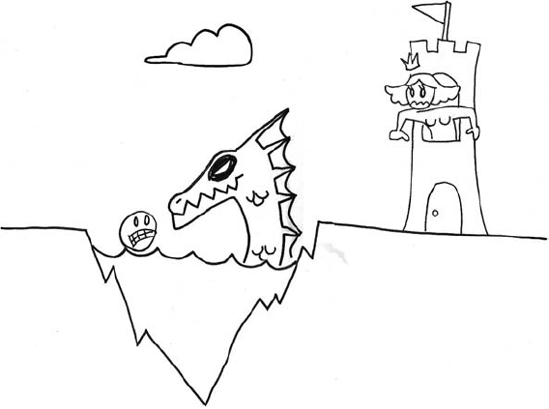
Finally, there is one last problem that threatens the hero with the most risk of all.
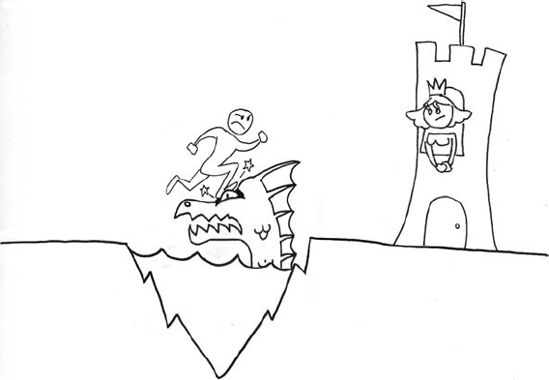
The hero must resolve the final problem...
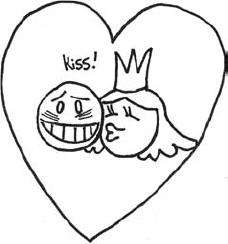
... in order to gain his object of desire. And everyone lives happily ever after. Well, until the sequel anyway.
Remember that no matter what your story is about, a story ALWAYS has a beginning, middle, and end. Hollywood has spent many years analyzing and deconstructing the story. Don't feel like you have to reinvent the wheel; learn what they have. Read screenwriting books, take classes, visit screenwriting websites. But you don't have to feel chained to a standard story structure like Joseph Campbell's "Hero's Journey" or Syd Field's "Three Act Structure." Try using another medium's structures to tell your story. How is a story told in a song? In a TV news report? In a Homeric poem? Or try looking to non-Western-world storytelling for inspiration.
Just remember that video games are an interactive medium, and as William Shakespeare reminds us, "The play's the thing." That was one guy who knew story, and he was pretty smart for someone who never played a video game. If gameplay is the meat of the game, then story should be the salt: just enough will add flavor but too much can ruin everything and kill you.
Some games don't even have stories. Games like Tetris or Bejeweled or even Pac-Man don't need them to be engaging for the player. However, they still generate a narrative, which literally means "an order of events." Since we humans perceive time as linear, we express our experiences linearly as well—even if they aren't presented in a traditional story structure. Let's look at it this way:
Every time a person plays a game they create a narrative. There are an infinite number of narratives that the player can create. As a designer, you need to look at all[37] of the narratives possible and find out how to make them ALL fun. The goal is to create multiple narratives that the player will enjoy playing.
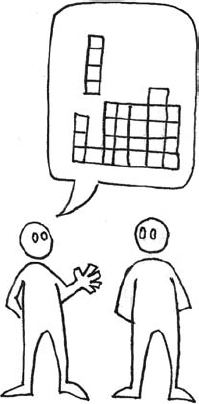
In a narrative, the player is the "hero" of the game. The designer needs to look at the game from the player's perspective and be aware of the ordering of the events and experiences that will eventually help the play create the narrative. As each experience builds on the next, the goal is to create rising emotional states for the player. Then the designer can design systems to choreograph these interesting experiences which in turn create emotions. Savvy? How about an example instead?
Left 4 Dead uses an artificial intelligence called the "Director" to control the game's pacing. Depending on the player's "stress level", which is calculated using many variables including health, skill, and location, the Director then adjusts the number of zombies that attack, what items like ammo and health are generated, and even the music. In the end, the game itself generates a unique and dynamic play experience for the player. However, since most developers don't yet have technology like Left 4 Dead's Director, it is up to the designer to create these situations as best they can within their own games.
When you are designing a game, it is extremely important to know the narrative that the player will experience. You'll find that the player's narrative can end up quite different to the game's story. Remember to never mistake story for gameplay, and similarly never mistake gameplay for story.
I am also a firm believer that almost ANYTHING can be made into gameplay. Don't feel like you are limited by subject matter. Look at games like Mr. Mosquito (the player is a mosquito who drinks the blood of a family), SimCity (the player builds and manages a city), and PaRappa the Rapper (dog raps to win the love of his flower girlfriend).
Still don't believe me? Let's look at the classic and simple story Little Red Riding Hood. This children's story has all the elements you'll need to make a great video game:
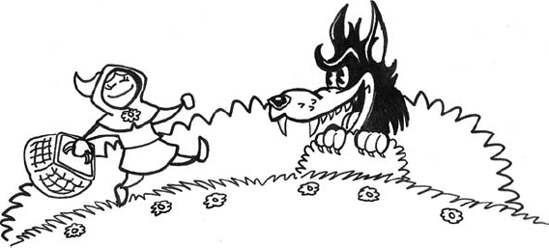
Little Red Riding Hood walks through the forest to Grandma's house = classic player exploration. Give Red some goodies to collect to fill up her picnic basket (inventory system) and have her jump over a fallen log or two on her way.
Red meets the Big Bad Wolf = the player has her first enemy encounter. Of course, you can't kill off the wolf yet ... (unless the enemies are "wolf minions").
Carrying a full basic set of goodies (gating mechanism), Red reaches Grandma's house (next level), where she finds "Grandma" waiting in bed.
Red questions "Grandma's" true identity ("what big eyes you have"). This can take the form of a quiz, a puzzle, or even a rhythm game.
"Grandma" is revealed as the Big Bad Wolf and Red and the wolf battle to the death = boss fight[38]!
See? Even a "simple" classic story can still offer all the elements to make an exciting and varied video game[39]!
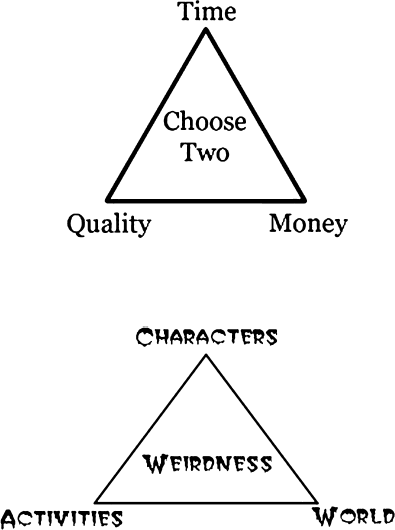
I am sure you have heard of the famous production triangle (see opposite).
One of the best things about video games is that, technical restraints of your chosen platform aside, you are limited only by your imagination.
Developers can craft virtual worlds that feature non-Newtonian physics, bizarre characters, and absurd quests. However, it is possible to go crazy with creativity, especially when writing the game story. This is why I created the "Triangle of Weirdness." Notice the difference in the choices on the triangle of weirdness: characters, activities, and world.
Unlike the production triangle where you can have any two points, you can only choose one corner on the triangle of weirdness. Choose any more than that and you risk alienating your audience.
Let's take a look at three examples of how to apply the Triangle of Weirdness to your story and world:
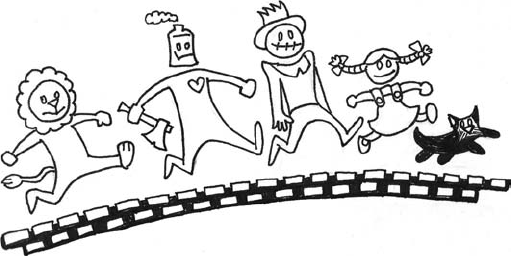
While the Wizard of Oz features weird characters such as a Tin Man, a Lion, and a Scarecrow, the land of Oz was a pretty typical fairy tale location when it was created in the 1900s. The characters of the Wizard of Oz have desires readers can relate to: courage, love, and wanting to return home.
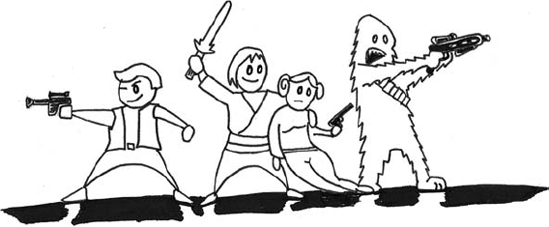
While the main characters of Star Wars are familiar (the young hero, the princess in distress, the charming rogue), and their desires are familiar (join the war effort, defeat the villains, get the girl), it is the world of Star Wars that is weird with its Jawas, Wookies, Jedis, and a Cantina populated by the craziest-looking scum in the galaxy.
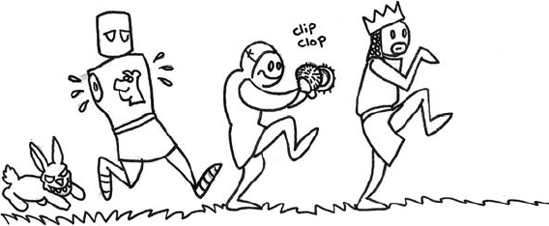
Monty Python and the Holy Grail features typical (if not archetypical) characters: King Arthur and his knights of the round table. These stalwart knights travel through medieval England on their quest for the Holy Grail. However, that quest is filled with weird activities like designing shrubs for the knights that say "Ni!" or being slaughtered by the killer rabbit of Caerbannog.
It is possible to go too far. Movies like Dune (1984) and The City of Lost Children (1995), or video games like SkullMonkeys or Muscle Man March, while incredibly unique and creative, just left many audiences feeling like they "didn't get it." And nobody likes to feel stupid.
What do these games and movies have in common? They all violate the Triangle of Weirdness. Do so at your own peril ...
When developing a game story, you will find there are three different types of people in your audience.
Players that are into your story as it happens.
Players that want to get into your story in depth.
Players who don't care what the story is at all[40].
Making your story appealing to all three types of players can be a challenge. The best rule of thumb is to always make the story be in service of the gameplay and not the other way around. Here are some tips on involving story into the game.
To satisfy players that are looking for a deeper experience, provide details but make sure they don't get in the way of the story. For example, Bioshock and Batman: Arkham Asylum both have non-mandatory collectable audiotapes that reveal deeper story details to the player without intruding in on the main story.
Players that are just along for the ride will "A button" their way through audio cues and cutscenes that reveal story points. Make sure your game's story is also revealed through gameplay and level design to prevent it being skipped entirely by the player; otherwise, the player will get lost and confused[41]. You can also introduce story as gameplay by making them playable flashbacks or puzzles.
Start your story as late into the action as possible. This can be in the middle of a boss fight, at the end of a level, or during a car chase. Keep in mind, this works best for games with traditional story. I'm not sure it's such a good idea to start a puzzle game of Tetris with dozens of tiles raining down on the player.
Always keep your stories lively and moving. Professional screenwriters will introduce a change in the plot or action every 15 minutes. Even with non-story games, play sessions are becoming "bite-sized" so they're short enough for players to enjoy in short bursts.
Speaking of surprises, there is a trend in game stories that I blame squarely on Hollywood: the twist/surprise ending. While it is fun to be taken by surprise, I believe there is merit to a predictable ending. Remember that wish fulfillment I said players want? People like it when the good guys win and the bad guy lose, and yet that's the oldest story in the book.
Take, for example, the James Bond movies of the 1980s. When I was growing up, I loved to go see those films. Even before I saw them, I knew that Bond was going to use a cool new gadget and drive an awesome car, defeat the villain's scheme, save the world, and end up with the hot girl. So, if I knew all of these things, why did I bother watching the movie? For me, the fun was the twists and turns the story took. I knew the WHO, the WHAT and the WHY, but I didn't know the HOW.
There is a delight in predicting how things will turn out. It makes the player feel smart, like they "called it" in an election or solved a mystery. Besides, life is unpredictable enough as it is, why not give your audience a little predictability? The point I am making is you don't have to be especially clever when writing your story, just entertaining.
Conversely, something that I don't find very clever is a video game story where the main character has amnesia. Amnesia ranks as the number one video game cliché of all time, but I understand why game writers do this. It's an attempt to approximate the lack of information about the characters and the world as a player begins the game. However, it ultimately becomes an excuse for the writer to be an "unreliable narrative" and intentionally omit information to the player in order to create a "shock ending." It just feels forced and frankly, isn't fair to the player.
Instead, here is a great theory about the value of surprise vs suspense from classic director Alfred Hitchcock. Imagine that there are two men sitting at a table talking about baseball. The conversation lasts for about five minutes, when suddenly, there is a huge explosion! This shocks the audience but that surprise only lasts about 15 seconds.
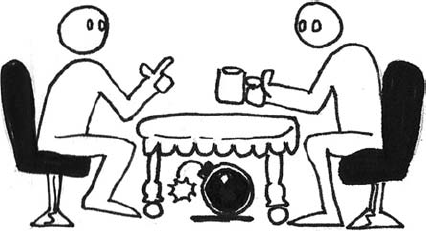
However, here is how you can get a greater impact from your audience. Start the scene by showing the bomb under the table. The bomb is set to explode in five minutes. The two men discuss baseball while the audience is squirming in their seats thinking "Don't just sit there talking about baseball! There's a bomb under the table! Get out of there!" By making the audience aware of the danger the characters are in, the audience gets emotionally involved. By the time your scene reaches its climax, you have created more excitement with your audience than just the surprise of the bomb exploding[42].
Another thing to consider when developing your story is "what is at stake?" Many video games are about saving the world from evil or destruction. But just like every movie doesn't have to be a slam-bang blockbuster, not every video game has to be about saving the world. Small themes can be just as important as big ones. In my opinion, using a theme for your story other than "violence solves all problems" is a worthwhile pursuit. It worked for games like Frogger, Zoo Tycoon, and Braid.
Ending games can be just as hard as starting them. In the good old days, there wasn't an end to a game, just a kill screen[43]. Or they just ran forever, frequently wrapping their scores around like your car's odometer. Then along came Dragon's Lair, and everyone wanted to know whether Dirk rescued the Princess or not. The video game story was born.
How long should a game be? In the old days, the average was 20 hours. In the really old days, it was 40. Nowadays, most games average 8–10 hours of playing time; however, depending on the game, this length might not always be appropriate. You'll have barely scratched the surface of Fallout 3 after 8 hours. I recommend ending the game when you feel like you have left the player feeling satisfied. You can leave plot points dangling to encourage replayability or to open up storylines for sequels, but in the end play fair with the player. Let them feel like they accomplished everything they needed to do during the game.
Some games even offer extra experiences so the player can continue playing after the story has ended. Multiple endings, minigames, unlockable and downloadable content or "deleted levels" (akin to deleted scenes on a DVD) will let your player return to your world without having to hear the same story over again. If you create a world that the player wants to play in, they will want to come back to play.
Or you can just throw away all of the previous advice and write your story at the last minute. Some development teams concentrate solely on the gameplay and create the storyline last. They claim it works. Personally, I think it would make me nervous.
Oh, I almost forgot to talk about one of the most important things about your game's story: the title! There are several ways to approach naming your game. They include:
The literal title
The action/cool title
The punny title
The "purple cow" title[44].
A literal title makes it easy to figure out where the title came from. It can be the name of your main character, like Sonic the Hedgehog or Voodoo Vince. It can be the main location of your game, like Castle Wolfenstein or Saint's Row. Or you can name your game after a gameplay activity or component like Command and Conquer or Boom Blocks.
The action/cool title is a title that captures the spirit of the game without mentioning any of the game characters or locations. I think games like Darksiders, Brütal Legend, and Gears of War all have cool titles.
The punny title is a title that makes you appreciate the cleverness of the title. Just Cause, Half Life, and System Shock are all good examples of punny titles. As puns are word play, you have to be careful as your audience may not get the reference or think the pun is funny. Humor is so subjective.
A purple cow title is one that makes your customer stop in their tracks and stare. It compels the reader to wonder why the title was chosen. Once the player has played the game, they understand the significance. Purple cow titles include LittleBigPlanet, Far Cry, and Resident Evil. The advantage to a purple cow title is once you've associated the word with their titles, it's hard for other people to use those words without conjuring up the image of the game. It's going to be a long time before anyone thinks of using the word Halo in their game title ...
No matter what naming convention you use, I think that shorter titles are better than longer ones. First of all, they are easier to remember and say. I like to keep them to two or three syllables like Star Wars, Don-kee Kong, Pac-Man or Hey-lo. I think this started because of marquee sizes on arcade cabinets: they needed to attract the player's attention, create some mystery, and describe the gameplay. "Defender" is still one of the best game names ever: it perfectly sums up the game in one three-syllable word.
Secondly, shorter titles are easier to make into logos for your game's start screen and read on the cover of a game's box. Don't forget to consider marketing aspects when you are creating your game's title. If you have to use a longer title or a subtitle, then still try to keep it short. Uncharted: Drake's Fortune combines a couple of purple cows to make a pretty good title. Players will want to know who Drake is and what his fortune is. Uncharted gives you the image of exploring or sailing into unknown and dangerous territory. Conversely, Batman: Arkham Asylum lets you know who you are playing and where it takes place.
Try to name your game sooner than later. I have always preferred the titles developers created over those made up by someone else in the team. If you wait too long, a publisher's marketing department will have to come up with the game's name for you—and believe me, you don't want that.
When you have finally named your game, you may discover that your great title is already in use or trademarked by someone else. Make sure you do a check with your publisher's legal department to make sure you can use your title before you become too attached to it. Even a quick word search on the Internet will help get you started.
Fellow designer Andy Ashcraft believes that video game developers only care about telling the second act of their story. I tend to agree with him. However, games that do that are missing an important part of the storytelling process[45]. In games, the second act is the grind that moves the player towards the third act which is the completion of the story; usually the last level and a boss fight. They skip the all-important first act to "cut to the chase." In video games, this is either done with a cutscene or, even worse, the game's manual—which no one ever reads[46]! This is a mistake. The first act is where the player is given an opportunity to find out about and care about the character. However, I believe you need that first act to get the player to bond with the character, even if you kill that character off repeatedly (common in video games) or radically change them into a killing machine. Case in point, you don't need to look any further than the movie Robocop.

In the film Robocop, the audience is introduced to police officer Alex Murphy. He's an honest cop and a decent guy fighting crime in futuristic Detroit. By page 25 of the script, you actually care about the guy and feel bad when he's gunned down by criminal scumbags. The second act kicks off when Murphy is rebuilt as the cyborg Robocop. Now this movie had several video game adaptations made, and in all of them, Murphy's death was only shown as a cutscene. The player would start the game as Robocop and the killing of bad guys would commence immediately[47]. But in our hypothetical Robocop game, why not start with Murphy as a cop? The first level of the game would have Murphy tracking down the bad guys and end with his death. The player would have time to bond with him, making his death and resurrection have much more of an impact.
Death should mean something to the player, especially when it isn't the main character dying. When was the last time you cried when a game character died? (Other than when you accidently deleted your save file?) Writers forget that you have to care about a character first if it is going to mean anything when you kill him. And the solution isn't to make the character a relative or part of a meaningful relationship, especially if that character is killed off in the first cutscene. I remember playing a game that opened with the player's relative getting murdered after interacting with him for one level. I didn't feel the righteous anger that the player felt for the rest of the game because I knew the character for such a short time. Invest the time in these characters, even if the ultimate goal is to kill them off.
Even better, make the character important to the player somehow. They can provide information on how to play the game, be the economy system (like the proprietor of the game's store), or provide health power-ups to the player on a regular basis. When that character is taken out of the game, the player will feel the impact. Spoiler alert, but in my humble opinion, the only game character whose death felt impactful was Aeris in Final Fantasy VII. Aeris filled many roles for the player; she was a damsel in distress, one part of the hero's love triangle, a character who contributed solutions to the problems in the plot, and a "playable" part of the gaming party. When she died, her loss to the player was felt on many levels. Build up your game characters before you tear them down. Make their loss count.
Your party members don't have to be human: the deaths of Agro the horse in Shadow of the Colossus and Dogmeat the dog in Fallout 3 have similar effects on players. All that matters is that your player has a bond with these characters to feel the loss when it happens.

All this talk about death has bummed me out. So, what about humor in games? Most writers agree that comedy is harder than drama. However, I believe that the secret to humor is character. My favorite first person shooter is Team Fortress 2, and I believe it is one of the funniest games I have ever played. The game doesn't feature humor like other games have; you won't find physical gags, "hilarious" jokes, or burping and farting. What makes the game so funny is how true the characters are to themselves. From the wry Australian sniper who has to defend his occupation to his parents, to the Russian heavy gunner who is overly fond of "sanviches." All of the game characters' appearances, animations, and vocal barks reinforce their personalities, raising them from stereotypes to truly original (and funny) characters.
If your game character is defined by a profession or activity, then make sure that the majority of the activities they do are related to that profession or activity. For example, if your player character is a demolitions expert, they aren't going to negotiate their way into a prison level to free their pal. They are going to BLOW IT UP! Heck, they may even blow up a door rather than turn the knob. When we were creating Maximo, we decided that he was an impatient guy, always in a hurry to rescue the princess or get into a fight. He didn't even stop to open a treasure chest; he just kicked it open, collected the treasure, and went on his way. If you start with your character's personality you will end up with some interesting animations and gameplay. Remember, characters have many motivations: success, revenge, love, acceptance, escape, hunger, responsibility, knowledge. Many characters have more than one; often conflicting motivations. Knowing their motivations will help you determine what your character will do and say. The result will be a much richer character.
Speaking of character, just like giving your game the right title is important, it is equally important to name your character correctly. Would you name a strapping barbarian hero Mortimer? Only if your hero is a parody or it's a comedy game. Names carry great weight. It is important to give your character the right name. Baby books are a great place to start. I like names that have some significance to the character's personality or what their occupation is. Star Wars has some of the best names. What does the name Luke Skywalker tell you about the character? Luke feels like a simple, homespun name fitting for a farm boy who yearns to "walk among the stars[48]."
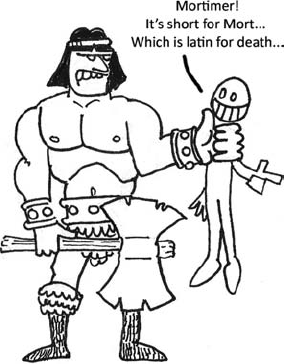
It's also fun to have characters' names juxtapose each other. Two of my favorite character names are from When Harry Met Sally. Billy Crystal's character is named Harry Burns—a curmudgeonly, burned out name if ever there was one. Meg Ryan's character is Sally Allbright. She's positive, romantic, and a little naïve. While these names are pretty blatantly obvious, they give you a quick snapshot of the character's personality.
Comedic characters need appropriate names too. Guybrush Threepwood, Spongebob Squarepants, and Larry Laffer aren't heroic sounding names, but they are totally appropriate for the humorous games they are in. The only rule of thumb is when you look at an image of the character; the name fits what you see.
Just because you are writing game stories for kids, doesn't mean it has to suck. The most common mistake kid game writers make is trying to make the story too simple. I have often heard developers protest over using complex ideas and themes because "it's for kids!" But think about children's literature. Children's classics like Where The Wild Things Are, Heidi or The Chronicles of Narnia are full of complex themes, interactions, and emotions. If it's good enough for kid's books, it should be good enough for kid's games. Coming of age doesn't only mean that the main character can carry a sword!
Another great thing about kid's games (heck, this applies to all games) is that you can teach your players things without them even knowing it. I am not talking about "edutainment", but the type of entertainment you used to find in movies and comic books. As a kid, I remember a Batman comic book in which I learned about famous comedians of the 1920s, the opera Pagliacci, African masks, and how paraffin wax discolors with age. That's some pretty impressive knowledge to gain from a "kiddie story." Don't be afraid to educate as well as entertain. Who knows, your players may learn something while they are having fun ... and you may learn something as you are writing your story.
A licensed game is when you create a game based on a pre-existing intellectual property[49]. This can be a character or world first seen in a movie, comic, real life, television, or even another video game. Star Wars, Batman, Harry Potter, and Spongebob Squarepants are all licensed characters and worlds, known as properties. The property is licensed by a publisher or developer, which means that a fee is paid to use the property for a game (or several games). The group who owns the original property is called the licensor. Licensors are groups like Lucasfilm, DC Comics, J.K. Rowling or Nickelodeon (to use examples from above). However, just because the licensee has paid to make a game using the character, that doesn't mean they can make any game they want. A licensee has to work with the licensor to adhere to the brand. For example, a licensor may not want their character to kill enemies. Therefore, the developer has to design their game around these "brand limitations." Some properties are pretty lenient to what developers can do with their properties, while others are very strictly moderated.
Don't dismay about having to stay within the confines of a license. With a good licensing partner, you can design a game that allows room for creativity. For example, I was working on a licensed game that had seen over 10 games previously based on it. Not looking forward to making just "another installment" of the property, we talked with the licensor about making the game in a genre that wasn't just a standard platformer. After we made our pitch, the licensor confessed that they were tired of creating the same style of game over and over, but had never considered taking the gameplay in another direction. The licensor gave us a lot more freedom than we had previously thought we had and, in the end, we produced a solid game. Just because you are working on a licensed game, don't assume that you are locked in to the "same old, same old." It never hurts to ask.
Here are a few tips I've picked up from working on licensed games:
Find out about the license inside and out. Read, watch, play everything you can on it. Go deep whenever possible. If you go in directions that aren't obvious or use characters that are more obscure, the fans of the brand will appreciate it. Every licensed game should be a celebration of the license and a big "thank you" to the fans.
Uncover the "big issues" early. Talk to your licensor and find out what the big "no no" issues are. Doing this will save you a lot of headaches and prevent you from making resources that will have to be changed later in production. For example, one game used hamburgers as a power-up. When the character ate them, he became invulnerable. However, even though it was never mentioned in any of the license's episodes, one of the main characters (one that was a playable character in our game) was a vegetarian. We had to change the power-up because the show's creators didn't like that we had their character "eating meat."
Get as much material as possible from the licensor. Television shows have "bibles"—detailed documents that outline the show characters and worlds. Established comic books have years of back issues that make great reference material. If your license is still in production (for example, if you are making a game for a movie with a simultaneous release) get hold of scripts, animatics, storyboards, and production photos as soon as possible.
If you are working on a movie license, visit the set (if applicable) and take your own reference pictures. Anything that helps you replicate the world of the license as closely as possible.
Respect the license, but find ways to make it your own. A two-hour movie may not have enough material to allow you to create an 8–10 hour game. Work with the licensor to expand the fiction to help you "fill in the gaps." Don't be afraid to bring your own interests to the party; those interests may fit in better to the brand's license than you may think.
There is much more I could tell you about writing stories, but I won't. This should get you started with your stories. Now, let's get back on track and talk about the foundations of gameplay: what I call the Three Cs!
Level 3's Universal Truths and Clever Ideas:
Some games need a story. Some games don't. All games need gameplay.
A story always has a beginning, middle and end.
Never mistake story for gameplay.
Almost ANYTHING can be made into gameplay.
Create a world the player will want to play in, and they will come back to play.
Make death matter.
Keep names short and descriptive.
Don't underestimate kids: they're smarter than you think.
Stay true to a license, but don't be afraid to "make it your own."
[37] Or as many as you can guess will happen. It's like playing a massive session of "what if." However, as these possibilities can stretch on to infinity, it might not be worth the time investment to predict everything. That's why when something happens that the designer didn't expect and doesn't break the game, we're more than happy to call it a "feature" and move on!
[38] We all know that Little Red Riding Hood ends with Red being eaten by the wolf and having the woodcutter save her, but where is the fun in that? Why watch a cutscene when you can have a boss fight? It's not my fault boss fights weren't invented when they wrote this story. Personally, I think my ending is better.
[39] OK, the story of Little Red Riding Hood might not make for a very LONG video game, but it can be made into a game nonetheless.
[40] I can't take credit for this observation. This statement was made by Ken Levine, the director of Bioshock, during his excellent 2009 GDC speech.
[41] Yeah, I know. It's their own damn fault if they get confused for skipping the cutscenes in the first place, but remember the first rule of responsible game design: love thy player.
[42] Hitchcock also recommends that you don't actually kill the characters in this scenario. In the case of video games, the game would be over!
[43] A kill screen originally wasn't the "game over" screen, but rather a screen that appeared due to a programming error or design oversight. The most famous kill screen from classic gaming is the 256th level of Pac-Man. At this point, due to a bug half the screen becomes garbled data, which keeps the player from collecting all of the dots and clearing the board to move on. Arcade owners had to unplug or "kill" the game to start it back up again.
[44] The term "purple cow" comes from the poem by Gelett Burgess who wrote: "I never saw a purple cow, I never hope to see one. But I can tell you anyhow, I'd rather see than be one."
[45] Remember, all stories have what? A beginning, middle and end.
[46] Maybe I am exaggerating a little, but c'mon. When was the last time you really read a game manual? Then again, when was a game manual worth reading?
[47] Just so you realize that I'm not a complete idiot, I do know why the developers of Robocop began the player as Robocop. (1) It's more appealing to play as a criminal-blasting cyborg than as a fragile human; (2) game carts in 1988 didn't have the memory to store two completely different player character models, and why would you go through all of the work to create them, especially if you were only going to be the human player character for one level; and (3) the game is called Robocop, not "Guy who gets shot and eventually becomes Robocop."
[48] Did you know that Luke Skywalker's original name was Luke Starkiller? This name change provides a great lesson: never give your character a name that gives away the ending of your story!
[49] There are also plenty of IPs that exist in the public domain: Cinderella, The Wizard of Oz, Dracula, The Three Musketeers, The Bible, Dante's Inferno to name a few. Remember to base your own work on the original material and not on someone else's interpretation.
